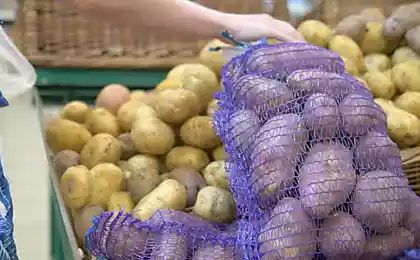536
When and how to dig potatoes
Here and August is coming to an end — it's time to dig potatoes. Like, it is simple enough, though time-consuming. But it turns out, also have their important "stuff" and tricks that can affect the quality of our harvest and to its storage. I propose to discuss the topic and share your cleaning experience the "second bread".

The important thing here is all: and time, and methods, and methods for preparing tubers for subsequent storage. But everything in order...
How to find out what time presotto we want to? Of course, a high yield, which will be perfectly preserved all winter. What do you need? So that the tubers are fully matured, gained weight, gained nutrients, and got a thick rind. And how to define that all this has happened? I want to know the exact date...
In our latitudes the "right" time to harvest potatoes in storage is the period from late August to September 10. But this is what is called "average temperature on hospital", because the actual ripening of the tubers is also influenced by the planting time, variety, and weather (climate) conditions, and characteristics of care — many circumstances can change the recommended dates. And how can that be? Are there any benchmarks? Of course, there is.
The most obvious and reliable sign is the dying off and drying of tops. If this happens, keep the tubers in the ground then it makes no sense. Moreover, if the delay in harvesting the Mature potatoes (and dying of tops just tells us that he has matured), to store the harvest will be much worse. After the foliage fades, the maximum period during which the tubers can remain in the ground, three weeks.
Cold approaching, and the foliage is greenish? Look at the weather. If you come early frost damaged shoots to postpone the cleaning is impossible: the plant will try to restore the foliage at the expense of nutrients accumulated in the tubers.
Some gardeners cut the potato tops before the harvest. In some cases this is appropriate, and how to do it?
Beveling the tops make sense if the timing of harvesting work, and it continues to grow (as happens, for example, in late planting). This is done to speed up the ripening of the tubers, which can be important on the threshold of the approaching cold. Only to hold such an event it is in advance: do not cut the shoots right before the harvest, give the plant 7-10 days to complete all biological processes. .
If the late blight attacked potatoes, the tops should also be cut and immediately destroy. The tubers in this case are left in the ground for up to 3 weeks so they have time to ripen fully and to form a solid skin that will not be damaged when cleaning.
In General, the hurry and the delay in the digging of potatoes and mean yield losses and deterioration in storage, so the question is, whether it is time to dig, — not idle, and it is very important to find the right (that is not theoretical, abstract, and quite specific — based on the real conditions!) the answer to it.
On the maturation of the potatoes is also affected:
The pitchfork can dig up the nest without damaging it and the land on them is not delayed, as on a shovel. On the other hand, who was not possible to chop the tuber at the tip? This also happens — maybe, rarely, but it happens. So, supporters of the use of the shovel claim incurred sharp cut on the air quickly Severinets, and the potato may have some time be stored, and a puncture from fork this is impossible.
I don't know... I do not keep potatoes damaged by digging a shovel, a pitchfork, though. Dug so, and the other — for me it is a matter of habit, someone handier than.
How to dig depends on the soil. In loose, well handled it is enough to gently pull the rest of the tops, to collect from it the tubers, choose those that remained in the ground and dig with a shovel or pitchfork to ensure that there is no "lost and found", buried a little deeper. And on a soft soil it is necessary to undermine the Bush to the side, trying not to damage the tubers.
It is very desirable to select the right planting material, choosing healthy tubers of medium size with the best bushes. Save them, trying not to mix varieties. Seed potatoes before harvesting would be nice proselyte — to withstand the light while the tubers did not flourish. So they can be stored better, and rodents they do not have claims.
If the weather allows, do not just put dug the tubers in the bags. Leave them on the ground for a couple of hours, scattering a thin layer. During this time, the potatoes dry out slightly and get the necessary treatment with ultraviolet light. Brief exposure to sunlight, according to experts, helps to disinfect the tubers and prevent the development of disease and rot during storage. Just do not overdo it — do not forget that if prolonged exposure to light the potato is green, it produces the poison solanine, which we did not need it.
Then dug up the potatoes sorted: select the small, damaged at harvest, diseased tubers. Something will have to just throw away, that will go to feed the birds or livestock (who have such animals), and potatoes with a little damage to eat in the first place.
Note: when digging, drying, sorting and cleaning is very desirable to once again pour, to throw the tuber to treat them carefully, this will prolong the shelf life.
Some of my friends potato before laying for storage wash. They say it is better stored. Not venture to recommend this method, because I've never used it — no need.
Sometimes the potatoes immediately collected in bags (boxes, buckets) and pour in a barn or shed to dry. Of course, when it's rainy, can't be choosers. But as a rule, to dry the tubers at the same time have longer and rotten in the end turns out to be more.
But even dried on the field potatoes, I would not advise at once to fill the bags and remove to the cellar, the chances of crop protection while significantly declining. Dug the tubers must undergo the so-called rehabilitation period. What it is and why it is needed?
First, not all problems can be noticed immediately — sometimes disease of the tuber appears after some time. If this occurs already during storage, a high probability of infecting the neighboring potatoes. During the rehabilitation period such hidden ailments often manifest themselves, and damaged potatoes can painlessly be removed.
Second, the potatoes placed in the appropriate conditions, it Matures, it dries and becomes tougher peel, providing the best safety, and the taste of the tubers wins. And what conditions are necessary? Required — high humidity (90-95%); the optimum temperature is about 18 degrees, but a decrease (up to +10...+13 degrees) is not critical, but would not have increased.
In such conditions I advise you to stand the potatoes about a month and a half. I usually goes no more than a month — the weather in our latitudes does not allow. Tubers can be placed in boxes or in bulk (if in bags, it is best net to good ventilation). And then remove them completely — for winter storage.
Time consuming? Maybe... But for example, I spent the time and effort is not sorry, because I can see the results: the potatoes are perfectly kept, the losses are minimal. And isn't that the goal?
Source: www.7dach.ru

The important thing here is all: and time, and methods, and methods for preparing tubers for subsequent storage. But everything in order...
How to find out what time presotto we want to? Of course, a high yield, which will be perfectly preserved all winter. What do you need? So that the tubers are fully matured, gained weight, gained nutrients, and got a thick rind. And how to define that all this has happened? I want to know the exact date...
In our latitudes the "right" time to harvest potatoes in storage is the period from late August to September 10. But this is what is called "average temperature on hospital", because the actual ripening of the tubers is also influenced by the planting time, variety, and weather (climate) conditions, and characteristics of care — many circumstances can change the recommended dates. And how can that be? Are there any benchmarks? Of course, there is.
The most obvious and reliable sign is the dying off and drying of tops. If this happens, keep the tubers in the ground then it makes no sense. Moreover, if the delay in harvesting the Mature potatoes (and dying of tops just tells us that he has matured), to store the harvest will be much worse. After the foliage fades, the maximum period during which the tubers can remain in the ground, three weeks.
Cold approaching, and the foliage is greenish? Look at the weather. If you come early frost damaged shoots to postpone the cleaning is impossible: the plant will try to restore the foliage at the expense of nutrients accumulated in the tubers.
Some gardeners cut the potato tops before the harvest. In some cases this is appropriate, and how to do it?
Beveling the tops make sense if the timing of harvesting work, and it continues to grow (as happens, for example, in late planting). This is done to speed up the ripening of the tubers, which can be important on the threshold of the approaching cold. Only to hold such an event it is in advance: do not cut the shoots right before the harvest, give the plant 7-10 days to complete all biological processes. .
If the late blight attacked potatoes, the tops should also be cut and immediately destroy. The tubers in this case are left in the ground for up to 3 weeks so they have time to ripen fully and to form a solid skin that will not be damaged when cleaning.
In General, the hurry and the delay in the digging of potatoes and mean yield losses and deterioration in storage, so the question is, whether it is time to dig, — not idle, and it is very important to find the right (that is not theoretical, abstract, and quite specific — based on the real conditions!) the answer to it.
On the maturation of the potatoes is also affected:
- the fertility of the soil: the poorer the land of nutrients, the sooner there will be time to dig potatoes; on fertile, well-fertilized plots the growth of tubers may continue until late autumn;
- the amount of moisture: its deficit during the vegetation period, will accelerate the maturation of the potato, so in dry summers in areas without irrigation, we see the early down and dead tops (though the yield in this case is often disappointing, because the tubers come small);
- high doses of fertilizers: a large number of introduced potato organics extends the maturity (and by the way, can increase the nitrate content in tubers, especially if you start harvesting prematurely).
- it is impossible to tighten with the cleaning if expected rains: waterlogging of the soil triggers the disease tuber rot, worsens the storability during storage; to dig potatoes with adhering earth not too easy and pleasant;
- the optimum temperature for the harvest of potatoes — not above +17 degrees, but not below +10: the cold can cause blackening of the tubers.
- it is best to dig potatoes in a clear bright day, when the tubers can be dried in air, and the soil is well cleaned and does not stick;
- the fall is not recommended to dig potatoes in the morning, when cooled during the night the air is much colder than the soil, still preserving the warmth of summer;
- to complete the harvest before the frost-resistant, which can damage not only the leaves, but the tubers in the ground.
The pitchfork can dig up the nest without damaging it and the land on them is not delayed, as on a shovel. On the other hand, who was not possible to chop the tuber at the tip? This also happens — maybe, rarely, but it happens. So, supporters of the use of the shovel claim incurred sharp cut on the air quickly Severinets, and the potato may have some time be stored, and a puncture from fork this is impossible.
I don't know... I do not keep potatoes damaged by digging a shovel, a pitchfork, though. Dug so, and the other — for me it is a matter of habit, someone handier than.
How to dig depends on the soil. In loose, well handled it is enough to gently pull the rest of the tops, to collect from it the tubers, choose those that remained in the ground and dig with a shovel or pitchfork to ensure that there is no "lost and found", buried a little deeper. And on a soft soil it is necessary to undermine the Bush to the side, trying not to damage the tubers.
It is very desirable to select the right planting material, choosing healthy tubers of medium size with the best bushes. Save them, trying not to mix varieties. Seed potatoes before harvesting would be nice proselyte — to withstand the light while the tubers did not flourish. So they can be stored better, and rodents they do not have claims.
If the weather allows, do not just put dug the tubers in the bags. Leave them on the ground for a couple of hours, scattering a thin layer. During this time, the potatoes dry out slightly and get the necessary treatment with ultraviolet light. Brief exposure to sunlight, according to experts, helps to disinfect the tubers and prevent the development of disease and rot during storage. Just do not overdo it — do not forget that if prolonged exposure to light the potato is green, it produces the poison solanine, which we did not need it.
Then dug up the potatoes sorted: select the small, damaged at harvest, diseased tubers. Something will have to just throw away, that will go to feed the birds or livestock (who have such animals), and potatoes with a little damage to eat in the first place.
Note: when digging, drying, sorting and cleaning is very desirable to once again pour, to throw the tuber to treat them carefully, this will prolong the shelf life.
Some of my friends potato before laying for storage wash. They say it is better stored. Not venture to recommend this method, because I've never used it — no need.
Sometimes the potatoes immediately collected in bags (boxes, buckets) and pour in a barn or shed to dry. Of course, when it's rainy, can't be choosers. But as a rule, to dry the tubers at the same time have longer and rotten in the end turns out to be more.
But even dried on the field potatoes, I would not advise at once to fill the bags and remove to the cellar, the chances of crop protection while significantly declining. Dug the tubers must undergo the so-called rehabilitation period. What it is and why it is needed?
First, not all problems can be noticed immediately — sometimes disease of the tuber appears after some time. If this occurs already during storage, a high probability of infecting the neighboring potatoes. During the rehabilitation period such hidden ailments often manifest themselves, and damaged potatoes can painlessly be removed.
Second, the potatoes placed in the appropriate conditions, it Matures, it dries and becomes tougher peel, providing the best safety, and the taste of the tubers wins. And what conditions are necessary? Required — high humidity (90-95%); the optimum temperature is about 18 degrees, but a decrease (up to +10...+13 degrees) is not critical, but would not have increased.
In such conditions I advise you to stand the potatoes about a month and a half. I usually goes no more than a month — the weather in our latitudes does not allow. Tubers can be placed in boxes or in bulk (if in bags, it is best net to good ventilation). And then remove them completely — for winter storage.
Time consuming? Maybe... But for example, I spent the time and effort is not sorry, because I can see the results: the potatoes are perfectly kept, the losses are minimal. And isn't that the goal?
Source: www.7dach.ru























